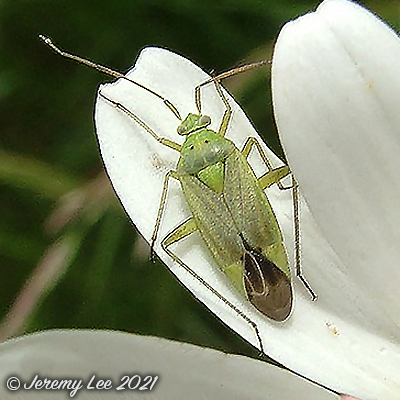
 |
|
Scientific Classifications explained » Amphibians » Ants » Aphids » Bees » Beetles » Birds » Bugs » Butterflies » Caterpillars » Damselflies » Dragonflies » Earwigs » Flies » Frog/Leafhoppers » Fungi » Galls » Grasshoppers » Harvestmen » Hoverflies » Lacewings » Ladybirds » Leaf Mines » Lichens » Mammals » Millipedes » Mosses » Moths » Sawflies » Slugs » Snails » Spiders » Trees & Shrubs » Wasps » Wild Flowers » Woodlice » Postboxes |
UK Nature > Bugs > Closterotomus norwegicus

Scientific Name: Closterotomus norwegicus Common Name: Potato Capsid Closterotomus norvegicus, more commonly known as the potato capsid, measures 6-8 mm in length and is a species of bug belonging to the family Miridae, subfamily Mirinae. It can be found feeding on nettle and clover as well as compositae, potatoes, carrots and chrysanthemums. They prefer to feed on the flowers, buds and unripe fruit. The species is found all over the UK and continental Europe. In 1997 it was moved from the Calocoris genus to its current name. The species is green coloured as a nymph but when they get to adulthood they can be tinged reddish-brown. It does however, vary by territory, for example some specimens from northern Britain have been found to be brownish-black. The prothorax has two spots while its scutellum has dark marks. The tibial spines are shorter than the width of the tibia, and the length of the 2nd antennal segment is roughly equal to the 3rd and 4th combined. Adult from May-October. |
|

https://www.uknature.co.uk is a website dedicated to showing the immense diversity of UK nature and wildlife. Our vast range of habitats, from lowland arable to snow covered mountains, from storm-ravaged coastlines to peaceful inland freshwater lakes and rivers, from dry, sandy heaths to deciduous and coniferous forests, all these habitats contribute to the abundance of UK nature. We have wild birds in huge numbers either residing or visiting our shores (597 recorded species as at July 2013) and we must also not forget the humble back garden with its grass lawns, flower beds filled with nectar rich flowers, shrubs and trees, all designed to attract huge numbers of insects such as bees, moths, butterflies and hoverflies; and finally the small ponds which provide safe havens for frogs, toads, newts and even slow worms and grass snakes. www.uknature.co.uk is the showcase for my personal passion, photographing uknature in all its glory. I sincerely hope you all enjoy the fruits of my labours. This site and all images contained therein is © Jeremy Lee 2004 - 2025. All Rights Reserved. Site design by Jeremy Lee. Site development & IT Support by Stuart Lee. |